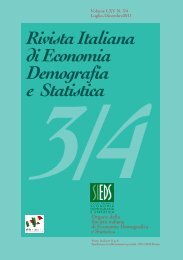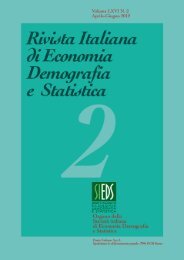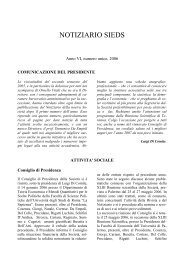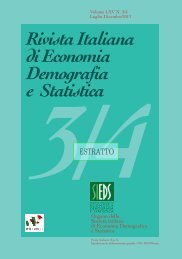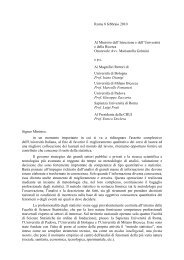rivista italiana di economia demografia e statistica - Sieds
rivista italiana di economia demografia e statistica - Sieds
rivista italiana di economia demografia e statistica - Sieds
You also want an ePaper? Increase the reach of your titles
YUMPU automatically turns print PDFs into web optimized ePapers that Google loves.
Rivista Italiana <strong>di</strong> Economia Demografia e Statistica 59<br />
Table 1 – Average equivalent income at PPP not inclu<strong>di</strong>ng and inclu<strong>di</strong>ng imputed rent.<br />
Without imputed rent<br />
With imputed rent<br />
Baseline=<br />
Baseline=<br />
Country<br />
Baseline=<br />
Baseline=<br />
Income Without<br />
Income Without<br />
EU4<br />
EU4<br />
IR<br />
IR)<br />
EU4 17,291 100.0 100.0 21,243 122.9 100.0<br />
ES 13,866 100.0 80.2 18,011 129.9 84.8<br />
FR 17,103 100.0 98.9 21,099 123.4 99.3<br />
IT 16,194 100.0 93.7 19,279 119.0 90.8<br />
UK 20,421 100.0 118.1 25,025 122.5 117.8<br />
By considering average income in the four European Countries (EU4) as a baseline,<br />
both inclu<strong>di</strong>ng IR (column 4 of table 1) or not (column 7 of table 1), we can analyze<br />
the possible changes in purchasing power for the <strong>di</strong>fferent Countries arising from the<br />
use of IR. ES presents the largest increase of the average equivalent income in respect<br />
of the average income without IR (80.2% vs 84.8%). To the opposite, the Italian<br />
relative position decreases in purchasing power (from 93.7% to 90.8%, -2.9 points),<br />
while FR and UK show a stable positioning (respectively around 99% and 118%).<br />
These results are to be integrated with the figures in table 2. Indeed, ES has the highest<br />
percentage of owner-occupiers households (81%), that is the subgroup with the highest<br />
level of figurative income coming from dwelling services; moreover, it presents an<br />
high level of average full rent at PPP, that is the base to estimate IR (column 3 of table<br />
2). It is interesting the case of IT in respect of UK: while the two Countries have quite<br />
similar relative size of owner-occupiers and tenants at market rate, the percentage of<br />
free tenants is higher in IT compared to UK, and the opposite holds true for tenants at a<br />
reduced market rate; free tenants account for an higher increase of figurative income,<br />
because they have the amount of estimated rent totally added to the income, while the<br />
other group adds only the part excee<strong>di</strong>ng the paid rents; furthermore, in UK it is<br />
extensively adopted the supply of public subsi<strong>di</strong>es for renting, component of income<br />
that has to be removed. In such a case we would have expected an increase of the<br />
relative income in IT in respect of UK, but it happens the opposite. This is probably<br />
due to the fact that the dwelling services in UK are consistently higher than the ones<br />
produced in the Italian market, this fact due to the much higher value of the rent market<br />
in UK, even when evaluated at equivalent income at PPP.



